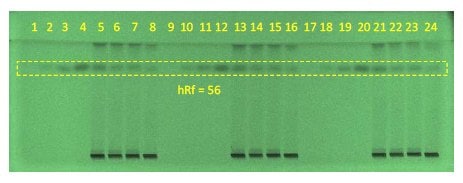Determination of Caffeine in Coffee Using High Performance Thin Layer Chromatography
Read more about
Introduction
High Performance Thin Layer Chromatography (HPTLC) is a very useful analytical technique and requires low sample preparation, here illustrated through the analysis of caffeine in coffee. Only extraction and filtration, through a 0.45 μm PTFE syringe filter, is needed for boiled coffee samples prior analysis. The HPTLC plate was pre-conditioned with the mobile phase, and a TLC-scanner was a used for the quantitation after the chromatographic separation was completed.
Results and Discussion
Caffeine was detected under UV light at 254 nm, hRf = 56, (Figure 1). A four-level calibration curve was constructed and used for quantitation purposes, (Figure 2). Each sample was analyzed in triplicate performed in parallel, a benefit with planar chromatography over both GC and HPLC.
| Track | Compound | hRf | [Caffeine] (mg/mL) | Application volume (µL) | [Caffeine] (mg/g) |
|---|---|---|---|---|---|
| 1, 2, 3, 4, 9, 10, 11, 12 17, 18, 19, 20 | Caffeine standard | 56 | 1.0 | 0.1, 0.5, 1.0, 2.0 | - |
| 5, 13, 21 | Filter Coffee 1 | 56 | 1 | 27.5 | |
| 6, 14, 22 | Filter Coffee 2 | 56 | 1 | 15.2 | |
| 7, 15, 23 | Pad Coffee | 56 | 1 | 15.5 | |
| 8, 16, 24 | Chai Latte | 56 | 1 | 4.9 |

Figure 1.Developed HPTLC plate at 254 nm, chromatographic data shown in the table above.

Figure 2.Calibration graph following the polynomial regression mode (r = 0.9970).
| Chromatography | |
|---|---|
| Plate | HPTLC Silica gel 60 F254, 20x10cm |
| Sample preparation | Caffeine standard diluted in Methanol; Coffee boiled with water and filtered with a 0.45 μm syringe filter. |
| Sample application | ATS4 (Camag) |
| Application volume | 0.1 to 2.0 μL |
| Pre-conditioning and mobile phase | Acetonitrile / Methanol / n-Heptane 6/4/1 |
| Pre-conditioning distance migration distance | 7 cm 5 cm |
| Migration time | 9 min |
| Detection | |
|---|---|
| Wavelength | UV light at 254 nm and 366 nm |
| Staining | None |
| MS equipment | expression CMS (Advion) |
| MS detection | ESI (+) mode (m/z 150 - 400) |
Pour continuer à lire, veuillez vous connecter à votre compte ou en créer un.
Vous n'avez pas de compte ?